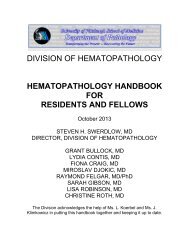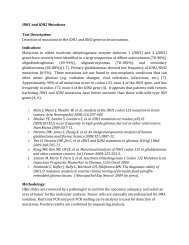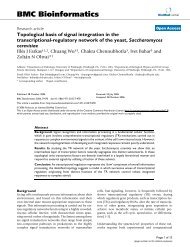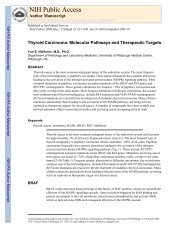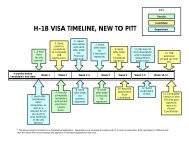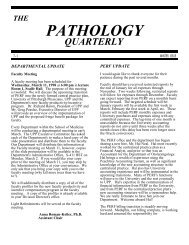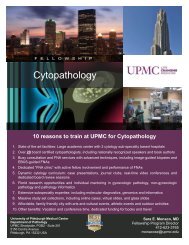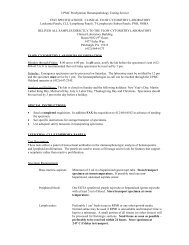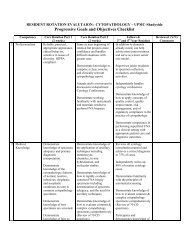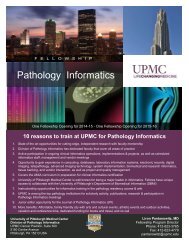Multiple Focal Nodular Hyperplasia of the Liver in - Department of ...
Multiple Focal Nodular Hyperplasia of the Liver in - Department of ...
Multiple Focal Nodular Hyperplasia of the Liver in - Department of ...
Create successful ePaper yourself
Turn your PDF publications into a flip-book with our unique Google optimized e-Paper software.
594 Kim et al.<br />
Journal <strong>of</strong><br />
Gastro<strong>in</strong>test<strong>in</strong>al Surgery<br />
that surround hyperplastic parenchymal nodules. The<br />
central scar conta<strong>in</strong>s an anomalous feed<strong>in</strong>g artery. 7,8<br />
The hepatocytes <strong>in</strong> <strong>the</strong> lesion are normal, and bile<br />
duct proliferation is usually prom<strong>in</strong>ent. 9,10 It is usually<br />
a stable lesion that does not enlarge over long periods<br />
<strong>of</strong> time. Rarely, it is complicated by growth, rupture,<br />
portal hypertension, hemorrhage, or necrosis. 11<br />
In this patient, <strong>the</strong> history and CT images mandated<br />
consideration <strong>of</strong> FNH, FHC, and hepatic adenoma <strong>in</strong><br />
<strong>the</strong> differential diagnosis. As compared to FNH, on CT<br />
imag<strong>in</strong>g, adenomas tend to be larger, more heterogeneous,<br />
may have hemorrhage, and lack a central scar.<br />
They generally have less arterial enhancement and<br />
may conta<strong>in</strong> fat. Fibrolamellar hepatocellular carc<strong>in</strong>oma<br />
tends to be large, have calcification, and be heterogeneous.<br />
It is also prone to hemorrhage and to<br />
have areas <strong>of</strong> necrosis. The lesions <strong>in</strong> this patient were<br />
large, heterogeneous, had little enhancement, and<br />
lacked a scar. Thus, on <strong>the</strong> basis <strong>of</strong> imag<strong>in</strong>g characteristics,<br />
<strong>the</strong> lesions <strong>in</strong> this patient were more consistent<br />
with adenoma or fibrolamellar hepatocellular carc<strong>in</strong>oma.<br />
As such, def<strong>in</strong>itive biopsy was <strong>in</strong>dicated.<br />
Histologically, adenoma and FHC can have similar<br />
characteristics to FNH. Adenoma is <strong>of</strong>ten composed<br />
<strong>of</strong> sheets <strong>of</strong> normal-appear<strong>in</strong>g hepatocytes without<br />
features <strong>of</strong> malignancy. There are few or no portal<br />
tracts or central ve<strong>in</strong>s, and bile ducts are absent. 12,13<br />
These features dist<strong>in</strong>guish adenoma from FNH.<br />
FHC may similarly be composed <strong>of</strong> sheets <strong>of</strong> hepatocytes.<br />
However, <strong>the</strong>se cells are dist<strong>in</strong>ctively plump<br />
and deeply eos<strong>in</strong>ophilic. Pale or hyal<strong>in</strong>e bodies <strong>in</strong> <strong>the</strong><br />
cytoplasm, prom<strong>in</strong>ent nucleoli, and rare mitoses are<br />
characteristic <strong>of</strong> FHC. 14<br />
The pathogenesis <strong>of</strong> FNH is unclear, but two predom<strong>in</strong>ant<br />
<strong>the</strong>ories exist. FNH may be a response to<br />
a preexist<strong>in</strong>g vascular abnormality. 8,15 The artery associated<br />
with <strong>the</strong> central scar is larger than normal<br />
and causes hyperperfusion <strong>in</strong> this region and/or arterialization<br />
<strong>of</strong> s<strong>in</strong>usoids, with result<strong>in</strong>g hyperplasia <strong>of</strong><br />
<strong>the</strong> surround<strong>in</strong>g parenchyma. Growth <strong>of</strong> surround<strong>in</strong>g<br />
hepatocytes stops when <strong>the</strong> s<strong>in</strong>usoids are compressed<br />
and vascular resistance <strong>in</strong>creases with slow<strong>in</strong>g <strong>of</strong> <strong>the</strong><br />
blood flow. 8 The second <strong>the</strong>ory relates to <strong>the</strong> use <strong>of</strong><br />
oral contraceptives. In contrast to adenoma, <strong>the</strong><br />
orig<strong>in</strong> <strong>of</strong> FNH has not been def<strong>in</strong>itively l<strong>in</strong>ked to<br />
estrogen, but based on isolated reports, it is still<br />
thought that estrogen may act as a growth factor<br />
and can <strong>in</strong>crease <strong>the</strong> size and vascularity <strong>of</strong> <strong>the</strong><br />
nodules. 8,16–18 Therefore, <strong>in</strong> any patient with FNH,<br />
<strong>the</strong> use <strong>of</strong> oral contraceptives should be strongly<br />
discouraged.<br />
Ano<strong>the</strong>r important f<strong>in</strong>d<strong>in</strong>g among patients with<br />
multiple FNH is an identified association with o<strong>the</strong>r<br />
vascular malformations and/or neoplasia. 19 The most<br />
frequent associations <strong>in</strong>clude arterial dysplasia, portal<br />
ve<strong>in</strong> atresia, berry aneurysm <strong>of</strong> <strong>the</strong> bra<strong>in</strong>, and pulmonary<br />
arterial hypertension. 16,19–21 There are additional<br />
associations with men<strong>in</strong>gioma, astrocytoma,<br />
liver hemangioma, and Klippel-Trenaunay and von<br />
Reckl<strong>in</strong>ghausen syndromes. 16,19,20,22 As such, patients<br />
with multiple FNH are advised to undergo CT or<br />
MRI <strong>of</strong> <strong>the</strong> bra<strong>in</strong> to detect treatable aneurysmal lesions.<br />
Despite such associated pathologic conditions,<br />
multiple FNH appears to have a good prognosis. Once<br />
<strong>the</strong> diagnosis <strong>of</strong> multiple FNH was secured, our patient<br />
underwent MRI <strong>of</strong> <strong>the</strong> bra<strong>in</strong>. This revealed no<br />
evidence <strong>of</strong> vascular malformations.<br />
Our patient’s presentation highlights <strong>the</strong> difficulty<br />
<strong>in</strong> mak<strong>in</strong>g <strong>the</strong> diagnosis <strong>of</strong> multiple FNH. The historical<br />
attributes <strong>of</strong> youth, postpartum status, female sex,<br />
and particularly oral contraceptive use raise suspicion<br />
for adenoma. The physical exam<strong>in</strong>ation f<strong>in</strong>d<strong>in</strong>g <strong>of</strong> a<br />
mass <strong>in</strong> her right upper quadrant was nondiagnostic<br />
but is, never<strong>the</strong>less, a most common feature <strong>of</strong> multiple<br />
FNH. 6,16,19,23 Radiographic evaluation by CT exhibited<br />
features more consistent with fibrolamellar<br />
hepatocellular carc<strong>in</strong>oma or adenoma, as opposed to<br />
FNH. MRI, which we <strong>of</strong>ten use to clarify equivocal<br />
CT f<strong>in</strong>d<strong>in</strong>gs, was not used <strong>in</strong> this case. Because <strong>the</strong><br />
features <strong>of</strong> this lesion gave us sufficient cause to suspect<br />
malignancy, we did not th<strong>in</strong>k that fur<strong>the</strong>r imag<strong>in</strong>g<br />
<strong>of</strong> any k<strong>in</strong>d would be sufficiently def<strong>in</strong>itive to<br />
Table 1. Cl<strong>in</strong>icopathologic dist<strong>in</strong>ction between focal nodular hyperplasia, hepatic adenoma, and fibrolamellar<br />
hepatocellular carc<strong>in</strong>oma<br />
Typical features FNH HA FHC<br />
Physical exam<strong>in</strong>ation Asymptomatic, RUQ pa<strong>in</strong> Asymptomatic, RUQ pa<strong>in</strong> Asymptomatic, RUQ pa<strong>in</strong><br />
CT exam<strong>in</strong>ation Central scar, feed<strong>in</strong>g artery Lesional hemorrhage, Calcifications, central scar<br />
hematoma, necrosis<br />
Histologic f<strong>in</strong>d<strong>in</strong>gs Central fibrous scar, sheets Sheets <strong>of</strong> hepatocytes, Sheets <strong>of</strong> hepatocytes,<br />
<strong>of</strong> hepatocytes, bile duct eos<strong>in</strong>ophilic <strong>in</strong>clusions, abundant fibrous stroma,<br />
proliferation absence <strong>of</strong> bile ducts prom<strong>in</strong>ent nucleoli, mitoses<br />
FNH focal nodular hyperplasia; HA hepatic adenoma; FHC fibrolamellar hepatocellular carc<strong>in</strong>oma; RUQ right upper quadrant;<br />
CT computed tomography.



